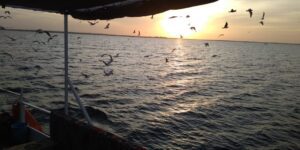Lake Nasser Temples (The Nubian Lake Temples)
Almost every Egyptian enthusiast is familiar with the Ancient Temples at North of Lake Nasser, especially at Philae, and they are equally familiar with Abu Simbel far to the south, but between them, there are some equally beautiful temples that deserve more recognition.
In the 1960s, the New High Dam was built in Aswan which resulted in a build-up of water that threatened to engulf the monuments along its Nubian shores. 100,000 Nubians were relocated due to the building of the dam, they were given homes in other areas around the lake. In a dramatic race against time, UNESCO began the incredible salvage operations, dozens of temples were dismantled and cut up into manageable-sized blocks, then painstakingly reconstructed, away from the dangers of the encroaching water.
Far more obscure are the temples that lie in between, South of the High Dam and North of Abu Simbel along with Lake Nasser. The land in between these monuments was once known as a part of Nubia.
As a result of a massive UNESCO effort, The Temples of Sebua and Amada areas are among the most important of the salvaged monuments on Lake Nasser.
What to see:
Sebua Area has situated around 152 km (95 miles) south of Aswan, and there are 3 temples to be seen:
1-The Temple of Wadi Al-Sebua:
The temple was actually built on the orders of Ramesses II (1304-1237 BC), utilizing at least some Libyan captives sometime around his 44th year as king.
The temple is dedicated to the Gods Re-Harakhte, Amun-Re, and the deified Ramesses II.
The front is free-standing and the rear was rock-cut. This temple consists of a sanctuary, a court, a hall, and pylons.
The Temple’s Sphinx-lined approach in the two forecourts leads to the initial stairway which provides the name of this area, which is known as the Valley of the Lions (Arabic: Wadi al Sebua).
Interestingly, however, this Ancient Temple was changed by the Early Christians, who converted the temple into a church, and now shows Ramesses II offering to St. Peter instead.
It was moved about 4 kilometers (3 miles) to the west from its original location, between 1961 and 1965.
2-The Temple of Dakka:
This temple was built by the Nubian Meroitic king Arkamani, in the late 3rd century BC, then decorated by the Ptolemies, and enlarged during the Roman Period.
It was built using fragments of an older temple; when the temple was moved, it was discovered to contain a number of reused blocks from the time of Hatshepsut and Tuthmosis III.
It was dedicated to Thoth of the Sycamore Fig.
By far the Nubian reliefs within the temple are the most interesting. They are small and precise in detail, depicting the Nubian king making offerings to the local gods of Aswan.
The temple was originally situated 40 km away. (25 miles) north of its present location, and moved between 1962 and 1968.
3-The Small Temple of Mahararqa:
Built during the time of the Roman ruler Augustan (30 BC-14 AD), this temple is dedicated to God Serapis and Isis. Interestingly, this small temple contains the only spiral staircase in any Nubian temple. However, this temple’s decorative theme was never completed. The most important remains are those of the Hypostyle Hall. It was moved to this location from its original site about 50 kilometers (31 miles) to the north.
The Amada Area is situated around 40km (25 miles) south of the Sebua area, and there are 2 temples and a tomb.
1. Temple of Amada:
The oldest of the temples, the Temple of Amada was built jointly by 18th-dynasty (1569-1315 BC) pharaohs Tuthmosis III and his son Amenhotep II, with a Hypostyle hall added by his successor, Tuthmosis IV.
Dedicated, like many temples in Nubia, to the gods Amun-Ra and Ra-Horakhty, it has some of the finest and best-preserved reliefs of any Nubian monument and contains two important historical inscriptions. The first, on a stele at the left (north) side of the entrance, describes the unsuccessful Libyan invasion of Egypt during Pharaoh Merenptah’s reign (1237-1226 BC), and a second stele on the back wall of the sanctuary describes Amenhotep II’s military campaign (1454-1419 BC) in Palestine, both no doubt designed to impress upon the Nubians that political opposition to the powerful Egyptians was useless.
Also, like many other Nubian temples, the early Christians made the structure a church capped by a cupola, and in the process, contributed their own damage. On the other hand, when these same Christians plastered over many of the reliefs, they in fact preserved many of them, making these depictions some of the finest remaining in any Nubian temple.
It moved about 2 kilometers (1 mile) from its original location, between 1964 and 1975.
2. Temple of Derr:
This rock-cut temple built by Ramesses II (1304-1237 BC) was dedicated to Himself, Amun-Re, Re-Horakhty, and Ptah. This rock-cut temple is well decorated with bright, visible colors and illustrates the Nubian campaign of Ramses II. Some of the temple’s decorations were lost due to its use as a church by early Christians. It was moved from near the Amada temple in 1964.
3. Tomb of Pennut:
Pennut was an administrator in Nubia during the reign of Ramesses VI (1156-1149 BC). This well-preserved Nubian tomb consists of a small offering chapel and a niche at the rear, with reliefs depicting events from Pennut’s life. It was the only Nubian tomb that was saved by the UNESCO Rescue campaign. It was originally situated at Aniba, 40km (25 miles) southwest of Amada.
Qasr Ibrim Island:
The last site before Abu Simbel is a large, mostly flooded island at Qasr Ibrim, but visitors may only gaze upon it from the comforts of a Lake Nasser Cruise boat, as it is no longer accessible by tourists. It once stood on the highest of three headlands on the East bank of the Nile some 70 meters (230 ft.) Above the River.
It once housed as many as 6 temples and a Roman-era fort; it was the last bastion of Paganism in Nubia.
We really do not know the exact origin of the site, though it may have originally been built up during the Middle Kingdom when the 12th Dynasty kings (1991-1786 BC) were establishing control of the trade route along The Nile. From the Pharaonic period, there are remains of rock-cut shrines to different Pharaohs and various gods dating to the New Kingdom (1569-1081 BC).
The Roman period remains to include a sizeable fortress probably from the time of Augustan (30 BC-14 AD). Also notable are the remains of a large basilica. Many artifacts such as leather, manuscripts, pottery as well as animal and botanical remains have provided considerable information on the daily life of people living at Qasr Ibrim.
Fishing Safari On Lake Nasser
A Fishing Safari on Lake Nasser is a must for those who enjoy “getting away from it all“. The areas where we fish are extremely remote and you will be literally completely cut off from the rest of the world. For those who have a sense of adventure and appreciate outdoor life, A Fishing Safari on Lake Nasser is a perfect match.
Lake Nasser is renowned for its fishing – for Nile perch (the largest caught weighed 176kg, just short of the world record), huge Tilapia, Piranha-like Tigerfish, and 18 kinds of Giant Catfish. After Tilapia (at the bottom of the food chain) spawns in mid-March, Perch and Catfish thrive in depths of up to 6m (20 ft.) till late September, after which big fish are caught in deeper water until February by trolling over submerged promontories or islands, and by the shore- or fly-fishing from March to July.
Summer season – the second half of March to the end of September. At this time, the Nile perch rests in shallow water, at depths of 2-6 m. This is due to the fact that at this time there is a spawning tilapia. This is the best time of year for fishing from the shore. Trolling at this time gives good results with smaller lures. August and September are very hot months and we do not recommend this time.
Winter season fishing – from October until the end of February. During this period, the lake is at the highest level, and perch is kept at great depths, gathering groups in anticipation of spawning, which occurs in January and February. In the winter season, fishing is usually done by trolling over underwater promontories, and sunken Islands. In October it’s still possible to fish from the shore, but later she did not give the result, and it comes to trolling and vertical jig.
If you want to catch really big fish, the winter season is the best choice. The summer season provides a wider range and greater number of fish, but the average trophy size in summer fishing is generally less than in winter fishing. However, summer fishing on Lake Nasser remains interesting and exciting, besides, small Nile perch, are species weighing 10 to 20kg.

